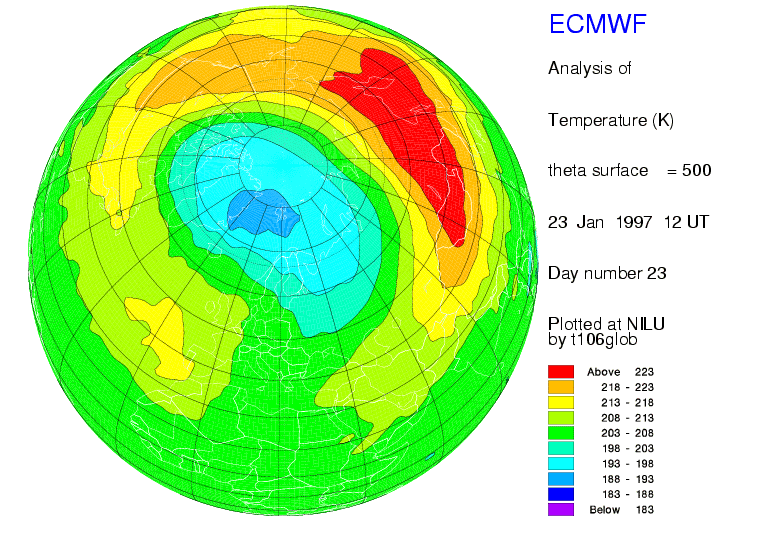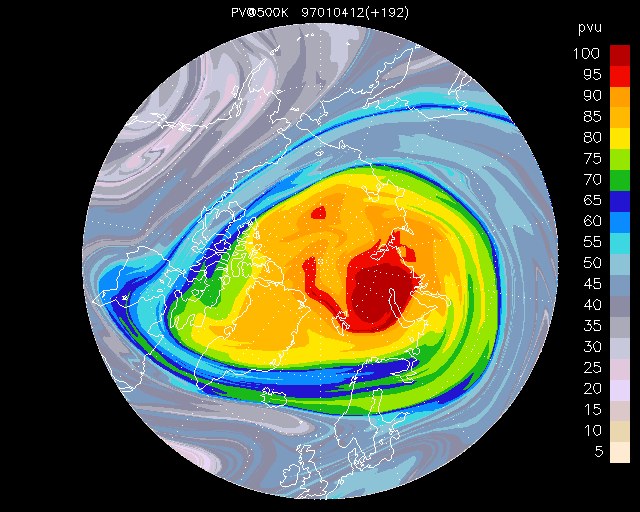
Fig.1: ECMWF-T106 500K temperature analysis for Jan.12, 1997, 12:00 UTC.
(1) Institute for Experimental Physics, Freie Universität Berlin,
Germany
(2) Alfred-Wegener-Institut Potsdam, Germany
(3) Geoforschungszentrum Potsdam, Germany
(4) Chemistry Department, Cambridge University, UK
FIGURES
Abstract
1. Introduction
Polar stratospheric clouds (PSC) provide particle surface for heterogenous chemistry leading to chlorine activation and thus to ozone destruction in the polar stratosphere in spring. In the Arctic, the temporal and spatial PSC occurrence is highly dependant on the variability of the polar vortex and the resulting temperature distribution. Atmospheric models usually assume large-scale PSC occurrence below TNAT, but observations lead to a more sophisticated view.
Different PSC types and formation conditions have been identified, and the role of stratospheric lee-wave events leading to PSC formation in Northern Scandinavia has been discussed in detail (Carslaw et al., 1998a+b; Dörnbrack et al., 1999). Still, the Scandinavian mountain ridge is not solely responsible for all mesoscale PSC incidents.
Here, PSC events observed by LIDAR (Light Detection and Ranging) in Sodankylä, Northern Finland (67.37°N, 26.65°E), and Ny-Ålesund, Spitsbergen (78.93°N, 11.95°E) are discussed.
The position of the observation sites relative to the polar vortex
is taken into consideration, focussing on filamentary structures
at the vortex edge. It is shown that other mesoscale processes
apart from lee-waves have an effect on PSC formation at the vortex
edge.
2. Observations
2.1 Data
Aerosol backscatter and depolarisation LIDAR data from Sodankylä and Ny-Ålesund are used to distinguish between different observed PSC types. The Sodankylä LIDAR system was in use for the Stratospheric Aerosols and Ozone in the Northern and Southern Hemisphere (SAONAS) project during winter 1996/97, 1997/98 and 1998/99.
The LIDAR system in Ny-Ålesund is a part of the Network for the Detection of Stratospheric Changes (NDSC). Aerosol backscatter data are available in different wavelengths combinations from 1988/89 on.
2.2 Difference between the observations
Although the exact microphysical formation process of PSC is still not completely understood, PSC are known to form and exist under a certain threshold temperature TNAT (NAT=nitric acid trihydrate). The particle formation also depends on the cooling rate and the time period below TNAT. Taking these facts into account for the PSC observations above Sodankylä and Ny-Ålesund, obscurities still remain.
On several days, the large scale temperature field would have been sufficiently cold for PSC occurrence at both stations but PSC were only observed above Sodankylä, while Ny-Ålesund did not detect enhanced aerosol in the stratosphere. The same facts can be applied to water ice PSC (PSC type II) which exist below the threshold temperature TICE.
Apart from a local adiabatic cooling due to mountain wave activity in Northern Scandinavia, it is possible that PSC formation is modulated by vortex edge processes. While Ny- Ålesund is mostly in the centre, Sodankylä is located at the edge of the polar vortex. Subject of our case study is the effect of mesoscale vortex edge dynamics on PSC formation above Sodankylä.
2.3 Case Study
Due to the meteorological stratospheric conditions, January 1997
is best suited for a comparison between the two stations. As Sodankylä
is situated in the lee of the Scandinavian mountain ridge, lee-wave
induced PSC occurrence is often possible. To exclude lee-wave
activity, we chose Jan12, 1997, for our case study. According
to Dörnbrack et al., 2000, lee-wave activity is not likely on that day.

Fig.1: ECMWF-T106 500K temperature analysis for Jan.12, 1997, 12:00 UTC.

Fig.2: Radiosonde temperature profiles for Jan.12, 1997, 11:00 UTC, in
Sodankylä (blue line) and Ny-Ålesund (red line). Also shown are the threshold temperature
for TNAT (black), TSTS(dark grey) and TICE (light grey). The blue bars mark the observed PSC in Sodankylä
Nevertheless, we identify mesoscale effects concerning PSC occurrence.
The synoptic-scale ECMWF 500K temperature analysis shows similar
temperatures for Ny-Ålesund and Sodankylä (Fig.1). According to
the radiosonde temperature profiles (Fig.2) and the temperature along the backtrajectories (Fig.3), particle formation was theoretically possible in Ny-Ålesund
and less likely in Sodankylä. Still, during 14 hours of measurements
in Ny-Ålesund no PSC was detected. In contrast, the Sodankylä
LIDAR observed a PSC layer in 21 to 23 km altitude (500-550K)
and another layer in 25.5-26km.

Fig.3: Temperature along the 525K-backtrajectories for Jan.12, 1997,
12:00 UTC, ending in Sodankylä (blue line) and Ny-Ålesund (red line).
The difference between the two observation sites is their orientation
relative to the polar vortex. While Ny-Ålesund is in the centre,
Sodankylä is located at the edge of the polar vortex where filaments
of vortex air and mid-latitude air coexist on mesoscale spatial
resolution. Fig.4 shows the 525K contour advection simulation
for the time of observation. Clearly, Ny-Ålesund is covered by
innermost vortex air, while Sodankylä is situated in an area of
mixed air masses. Here, mesoscale filaments with different properties could promote PSC
formation.

Fig.4: Contour advection simulation for Jan.4 + 192h 1997, on the 500K-surface. PV-units refer to Lait’s PV.
3. Discussion
The common explanation for the larger probability of PSC genesis in Sodankylä is the possibility of lee-waves. Those mesoscale waves may be induced by the Scandinavian mountain ridge and propagate upwards into the stratosphere, where adiabatic cooling leads to temperature fluctuations. Thus, the local temperature may fall below TNAT and induce particle formation.
Another possibility for the enhanced incidence of PSC above Sodankylä could be the different distribution of trace gases at the vortex edge compared to the vortex centre. As TNAT and TICE both highly depend on the H2O amount in the stratosphere, areas of enhanced H2O may lead to PSC formation by raising the threshold temperature. A positive anomaly of 1 ppmv in water vapor amounts in a raise of about 1 K in the threshold temperature.
As the vortex edge is an area of high filamentation, laminae in
ozone profiles are frequently observed (Reid et al., 1993; Manney et al., 1998) and can be expected in other trace gases. With laminae in water
vapor, TNAT locally can be raised.
4. Conclusion
In Ny-Ålesund, in the centre of the polar vortex, the synoptic scale conditions with temperatures below TNAT were not always sufficient for particle formation. Under the same synoptic scale conditions in Sodankylä, at the edge of the polar vortex, mesoscale structures induced PSC formation.
In our case study, lee-wave activity can be excluded according to Dörnbrack et al., 2000. Therefore, we could show that other mesoscale processes apart from lee-waves influence PSC formation at the vortex edge.
Dynamical processes at the vortex edge enhance the probability of PSC formation. At the vortex edge, mesoscale air filaments with different properties exist side by side. Intrusions from mid-latitudes contain more condensation nuclei, while filaments from upper polar vortex air contain more water vapor. At the same temperature, filaments with enhanced H2O content provide a higher threshold temperature TNAT for PSC formation.
Thus, mesoscale PSC formation may not be restricted to mountain
ridges, but may occur everywhere at the edge of the polar vortex.
References:
Carslaw, K.S., M.Wirth, A.Tsias, B.P.Luo, A.Dörnbrack, M.Leutbecher, H.Volkert, W.Renger, J.T.Bacmeister, E.Reimer, T.Peter (1998): Increased stratospheric ozone depletion due to mountain-induced atmospheric waves. Nature, Vol.391, p.675-678
Carslaw, K.S., M.Wirth, A.Tsias, B.P.Luo, A.Dörnbrack, M.Leutbecher, H.Volkert, W.Renger, J.T.Bacmeister, T.Peter (1998): Particle microphysics and chemistry in remotely observed mountain polar stratospheric clouds. J.Geophys.Res., Vol.103, p.5785-5796
Dörnbrack, A., M.Leutbecher (1999): Mountain wave induced record low stratospheric temperatures above Northern Scandinavia. Tellus, 51A, p.951-963
Dörnbrack, A., M.Leutbecher, J.Reichardt, A.Behrendt, K.-P.Müller, G.Baumgarten (2000): Relevance of mountain wave cooling for the formation of polar stratospheric clouds over Scandinavia: Mesoscale dynamics and observations for January 1997. J.Geophys.Res., accepted
Manney, G.L., J.C.Bird, D.P.Donovan, T.J.Duck, J.A.Whiteway, S.R.Pal, A.I.Carswell (1998): Modeling ozone laminae in ground-based Arctic wintertime observations using trajectory calculations and satellite data. J.Geophys.Res., Vol.103, p.5797-5814
Manney, G.L., J.C.Bird, D.P.Donovan, T.J.Duck, J.A.Whiteway, S.R.Pal, A.I.Carslaw (1999): Modeling ozone laminae in ground-based Arctic wintertime observations using trajectory calculations and satellite data. J.Geophys.Res., 103, p.5798-5814
Reid, S.J., G.Vaughan, E.Kyrö (1993): Occurrence of ozone laminae
near the boundary of the stratospheric polar vortex. J.Geophys.Res., Vol.98, p.8883-8890
Acknowledgments:
Backtrajectories have been calculated based on the source code by E.Reimer, Institute for Meteorology, Freie Universität Berlin.
Back to
| Session 1 : Stratospheric Processes and their Role in Climate | Session 2 : Stratospheric Indicators of Climate Change |
| Session 3 : Modelling and Diagnosis of Stratospheric Effects on Climate | Session 4 : UV Observations and Modelling |
| AuthorData | |
| Home Page | |